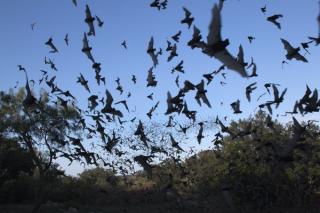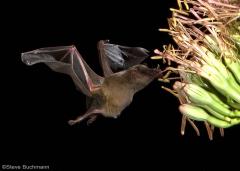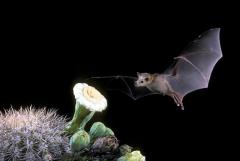Bat Pollination

Bats are very important pollinators in tropical and desert climates. Most flower-visiting bats are found in Africa, Southeast Asia, and the Pacific Islands.

Two species of nectar-feeding bats, the lesser long-nosed bat and the Mexican long-tongued bat, migrate north a thousand miles or more every spring from Mexico into Arizona, New Mexico and Texas. Both species are listed as vulnerable by NatureServe. The lesser long-nosed bat was removed (delisted) from the Federal List of Endangered and Threatened Wildlife due to recovery on April 18, 2018.
Also see:
Bat Flowers

The flowers that are visited by bats are typically:
- Open at night;
- Large in size (1 to 3.5 inches);
- Pale or white in color;
- Very fragrant, a fermenting or fruit-like odor; and/or
- Copious dilute nectar.
Bats feed on the insects in the flowers as well as on the nectar and flower parts, such as calabash, sausage tree, areca palm, kapok tree, banana.
Over 300 species of fruit depend on bats for pollination. These fruits include:
- mangoes,
- bananas, and
- guavas.
The Agave plant and the Saguaro, state cactus of Arizona, also depend upon bats for pollination. The agave is an important plant because it is used to make tequila.
To learn more about bats and bat pollination, visit Bat Conservation International's website.
